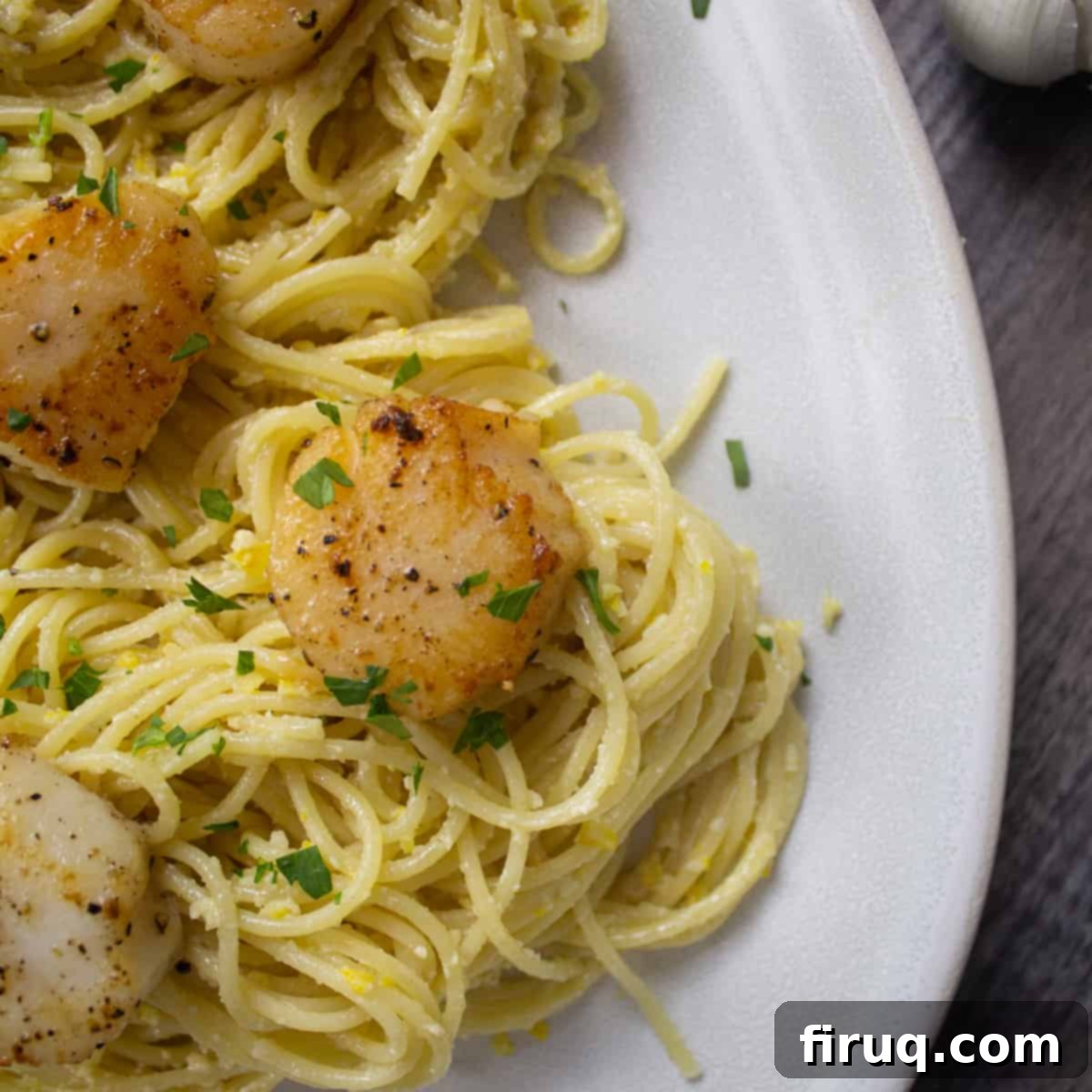Lemon Pesto Spaghetti with Seared Scallops: A Taste of Sunshine, Anytime
Imagine a dish that’s both intensely flavorful and surprisingly light, offering a burst of sunshine with every bite. Our **Lemon Pesto Spaghetti with Scallops** is exactly that – a quick, elegant pasta recipe where tender spaghetti is coated in a vibrant, creamy lemon pesto, perfectly complemented by delicate, seared scallops. This unique pesto, crafted from boiled lemon rinds and rich Parmesan, delivers a tangy twist that will awaken your taste buds and impress at any dinner table.
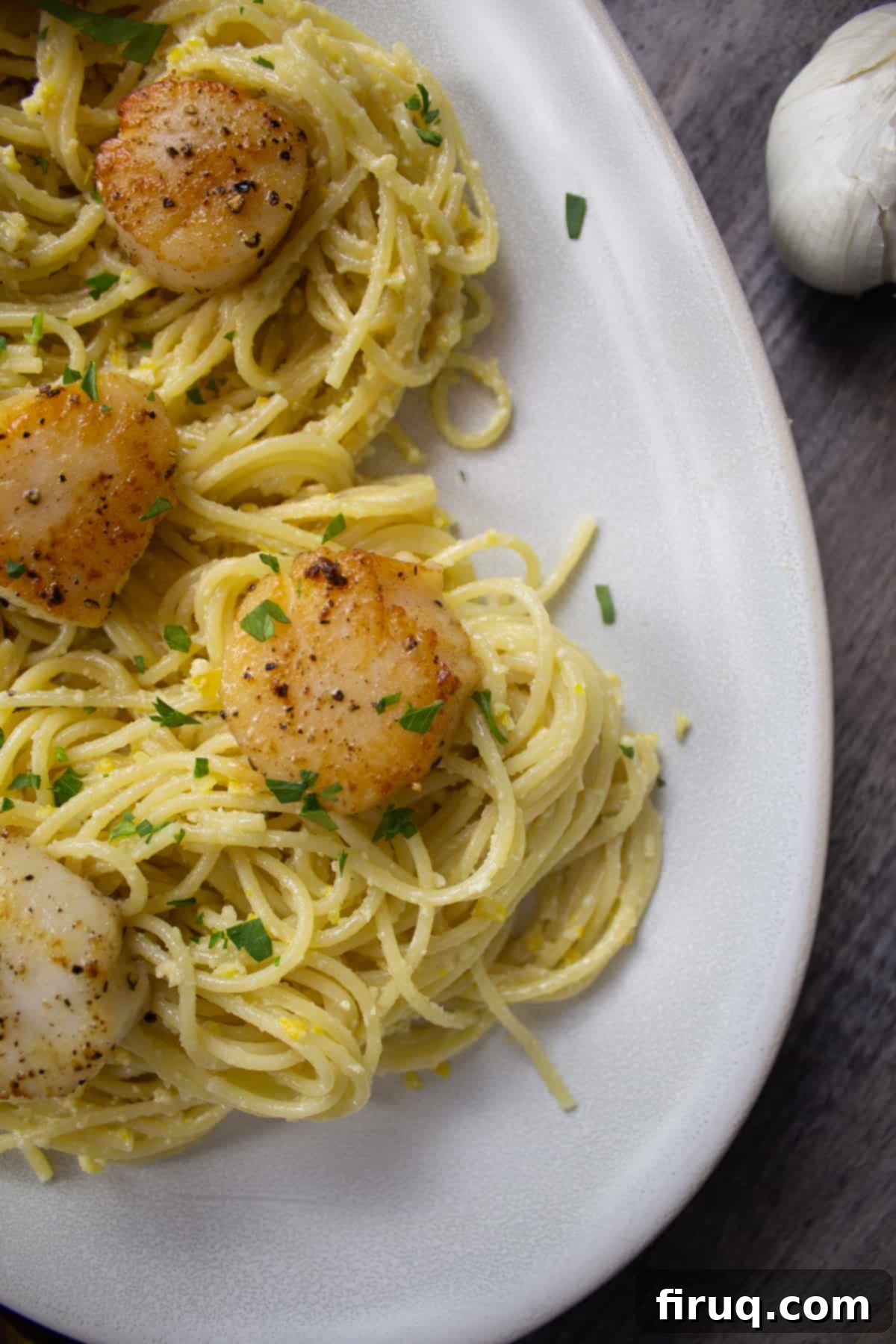
Craving more delicious pesto-inspired creations? Explore our delightful Creamy Pesto Shrimp Pasta or savor the authentic flavors of Busiate with Pesto Trapanese.
The Allure of Lemon Pesto: A Seasonal Delight
The inspiration for this unique lemon pesto struck during a time when fresh basil felt like a luxury item. While basil pesto reigns supreme in the summer, finding quality, affordable basil in the colder months can be a challenge. That’s when I discovered the magic of lemon pesto – a brilliant alternative that offers an equally vibrant, yet distinctly tangy, flavor profile. It brings a much-needed taste of summer to your plate, no matter the season. The first bite of this bright and creamy concoction, with its nutty undertones from Parmesan and toasted cashews, immediately convinced me this was a recipe worth sharing. Pairing it with seared scallops, one of my absolute favorite seafood, felt like a natural, elevated choice.
This lemon pesto isn’t just a substitute; it’s a star in its own right. Its bright acidity cuts through the richness of the pasta and the delicate sweetness of the scallops, creating a beautifully balanced dish. The technique of boiling the lemon rinds is crucial here, mellowing their bitterness and allowing their essential oils to infuse the pesto with an unparalleled citrus aroma and taste. It’s a simple step that makes all the difference, transforming ordinary lemons into something truly extraordinary.
Ingredient Notes and Substitutions for Perfect Flavor
Achieving the perfect balance in this dish relies on quality ingredients and understanding how each component contributes to the overall flavor. Here’s a deeper dive into our key players:
Cashews: The Mild Nutty Base
Cashews are an ideal choice for this lemon pesto. Their subtle, creamy texture and mild flavor complement the lemon beautifully without overpowering it. Plus, their light color keeps the pesto’s vibrant yellow hue intact. If you’re looking for alternatives, **pistachios** or **pine nuts** would also work wonderfully, adding their own distinct notes. However, be mindful that these nuts tend to be pricier, which can increase the overall cost of your dish. Toasting the cashews (or any nut you choose) is a small but essential step that intensifies their nutty flavor, adding depth to the pesto.
Extra Virgin Olive Oil: The Foundation of Flavor
In a dish like this, where the majority of the sauce is prepared without heat, the quality of your Extra Virgin Olive Oil truly shines. It’s not just a binder; it’s a significant flavor component. I highly recommend investing in a good quality, cold-pressed extra virgin olive oil. Look for oils that are “single olive made,” meaning they are produced from a single type of olive. This often results in a more distinct and consistent flavor profile. A robust, fruity olive oil will lend a beautiful peppery finish and silky texture to your pesto, enhancing every spoonful.
Parmigiana-Reggiano: The King of Cheeses
When it comes to cheese, there’s Parmesan, and then there’s Parmigiana-Reggiano – the authentic Italian cheese with a protected designation of origin. For optimal flavor, we always recommend using true Parmigiana-Reggiano. However, some high-quality American-made parmesans can also be excellent. The most important tip, though, is to **always buy a block** of cheese and grate it yourself. Pre-shredded or pre-grated Parmesan often contains anti-caking agents and preservatives (like cellulose) to prevent clumping. These additives can negatively impact the cheese’s melting properties and flavor, leading to a less creamy and sometimes gritty texture when cooked or melted into a sauce like pesto.
Step-by-Step Directions for Your Lemon Pesto Spaghetti
Creating this flavorful lemon pesto and pairing it with spaghetti and scallops is simpler than you might think. Follow these detailed steps for a dish that tastes gourmet:
Preparing the Lemon Pesto:
- Toast the Cashews: Add the cashews to a small, dry pan over medium-high heat. Toss them frequently for about 5 minutes until they are lightly golden and fragrant. This step enhances their nutty flavor. Remove from heat and let cool.
- Roast the Garlic: Preheat your oven to 400°F (200°C). Place garlic cloves (still in their husks) on a small baking pan, drizzle with a little olive oil, and roast for 15 minutes. Roasting mellows the garlic’s pungency and gives it a sweet, caramelized flavor perfect for the pesto. Once done, remove and let cool slightly.
- Carefully Peel the Lemons: For this pesto, we need just the bright yellow zest, carefully avoiding the bitter white pith. Using a sharp knife or a vegetable peeler, carefully peel the lemons, removing only the yellow part of the skin. Try to leave as much of the white pith behind as possible. The pith can make your pesto bitter, so precision is key here.
- Blanch the Lemon Peels: Place the peeled lemon rinds in a small pot with enough water to cover them. Bring the water to a boil and boil for exactly 5 minutes. This crucial step softens the peels, making them easier to process, and significantly reduces any bitterness, ensuring a beautifully tangy pesto. After boiling, remove the peels from the pot and drain thoroughly. Let them cool for about 5 minutes.
- Blend the Pesto: In a food processor, combine the toasted cashews, roasted garlic (squeezing the softened garlic out of its husk), and the cooled lemon peels. Process until these ingredients are finely ground and well combined.
- Add Olive Oil and Seasoning: With the food processor running, slowly pour in half of the extra virgin olive oil. Continue processing until the mixture starts to emulsify. Then, add the kosher salt and grated Parmesan cheese, processing until smooth.
- Achieve Creamy Consistency: Continue to slowly pour in the remaining olive oil until the pesto reaches a soft, creamy, and pourable texture. It should resemble a traditional basil pesto in consistency but with a beautiful pale yellow hue. Taste and adjust salt if needed.
Pro-Tips for Lemon Pesto and Scallops
- Pesto Consistency: While we suggest ½ cup of olive oil, the exact amount might vary. Adjust as necessary, adding a little more until your pesto achieves a smooth, pourable, and creamy texture that coats the spaghetti beautifully.
- Pasta Water is Gold: Always reserve some pasta water! This starchy liquid is your secret weapon for creating a silky-smooth sauce that clings perfectly to the spaghetti. It helps the pesto emulsify and prevents it from becoming too thick or oily.
- Flipping Scallops Like a Pro: Many home cooks don’t have a specialized fish spatula small enough for delicate scallops. A butter knife is a fantastic alternative! It’s thin enough to gently slide under the scallop without damaging its crust, and you can use your finger to lightly hold the top for a precise flip. This prevents tearing and ensures that beautiful golden-brown sear.
- Don’t Overcook Scallops: Scallops cook very quickly. Overcooked scallops become rubbery. Follow the searing times diligently for a tender, juicy interior.
Combining Pesto with Spaghetti:
- Finish the Pesto with Pasta Water: Once your spaghetti is al dente, reserve about ½ cup of the starchy pasta water. Let it cool slightly while you strain the pasta. Add a few tablespoons of this reserved pasta water to your pesto in the food processor and give it one last quick pulse. This step helps create a smooth, emulsified sauce that coats the pasta beautifully.
- Toss and Serve: Immediately after straining, return the hot spaghetti to its pot or a large mixing bowl. Add the lemon pesto and stir thoroughly until every strand of spaghetti is evenly coated. The heat from the pasta will help the pesto to warm through and cling perfectly.
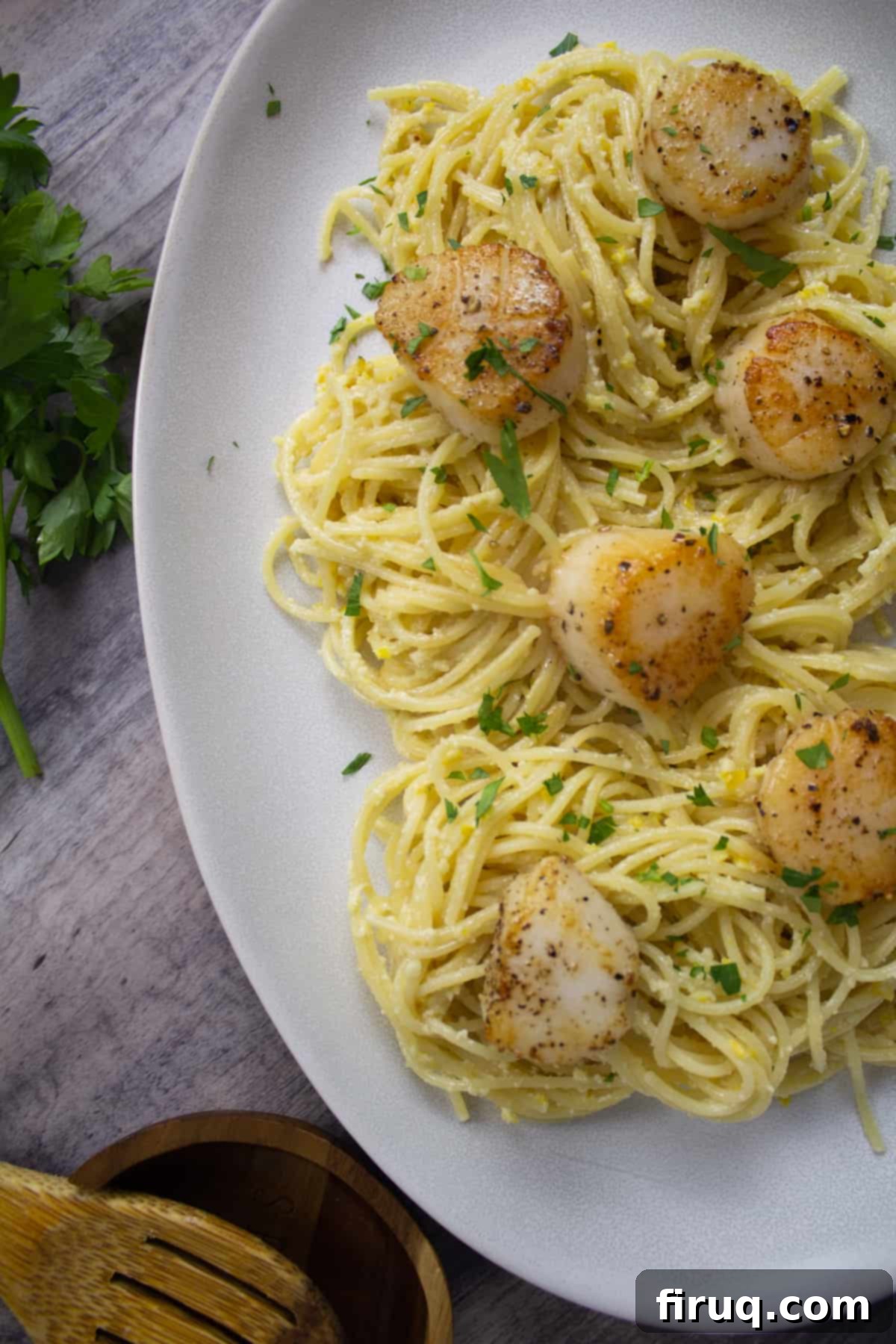
Mastering the Perfect Sear for Your Scallops
While the lemon pesto spaghetti is bursting with flavor, we keep the scallops preparation beautifully simple to highlight their natural sweetness and delicate texture. Achieving a golden-brown crust and a tender, translucent interior is easier than you think with these steps:
- Prepare the Scallops: Start by gently removing the small, tough muscle on the side of each scallop. This muscle is usually whiter than the rest of the scallop and should peel off easily. Pat the scallops thoroughly dry with paper towels; this is absolutely crucial for a good sear. Season generously with salt and pepper on both sides.
- Heat the Pan: Place a heavy-bottomed pan (cast iron or stainless steel works best) over medium-high heat. Add avocado oil (or another high-smoke-point oil) to the pan. You’ll know the pan is ready when the oil begins to shimmer, just before it starts smoking.
- Sear for Golden Perfection: Carefully add the scallops one at a time to the hot pan, ensuring they are not touching. Overcrowding the pan will lower the temperature, causing the scallops to steam rather than sear, preventing that desirable golden-brown crust. If necessary, sear in batches. Cook undisturbed for approximately 90 seconds until a beautiful golden-brown crust forms.
- Flip and Finish: Using a butter knife or a very small spatula, carefully flip each scallop. Sear the other side for another minute.
- Baste for Extra Flavor: Reduce the heat slightly and add 2 tablespoons of unsalted butter and a smashed clove of garlic to the pan. As the butter melts, tilt the pan and use a spoon to baste the scallops with the fragrant butter-garlic mixture for about 1 minute. This adds a wonderful depth of flavor.
- Serve Immediately: Remove the perfectly seared scallops from the pan and serve them directly over your lemon pesto spaghetti. Enjoy them while they are still warm and tender.
Don’t be intimidated by scallops! Just remember the “90-60-baste rule” (90 seconds one side, 60 seconds other side, 60 seconds basting), and you’ll achieve perfectly cooked, restaurant-quality scallops every time.
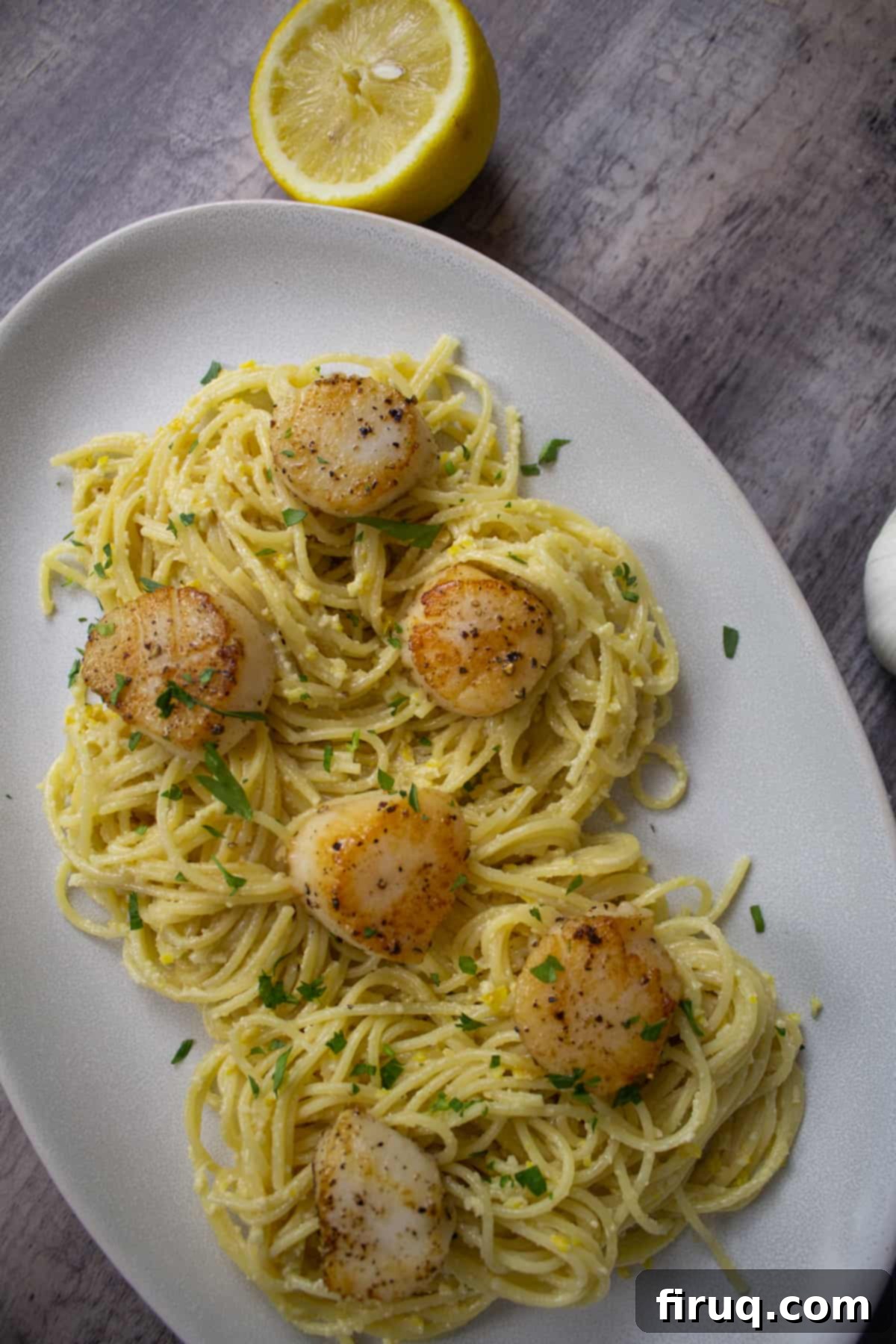
There’s something truly special about the “bright” flavor of lemon, isn’t there? This recipe, with its zesty lemon pesto, always transports me to warmer days, even in the dead of winter. It’s a culinary escape, a reminder that fresh, vibrant flavors are always within reach.
Frequently Asked Questions
Lemon pesto is a vibrant sauce typically made from carefully peeled and blanched lemon rinds, grated Parmesan cheese, toasted cashews (or other nuts like pine nuts or pistachios), roasted garlic, high-quality extra virgin olive oil, and kosher salt. It offers a tangy, creamy flavor profile distinct from traditional basil pesto.
Reheating scallops can be tricky as they tend to become rubbery if overcooked. For best results, quickly sauté them in a hot pan with a small amount of butter or olive oil for about 30-60 seconds per side, just until warmed through. Avoid microwaving, as this almost always leads to a chewy texture.
For optimal freshness and texture, it’s best to store the seared scallops separately from the spaghetti and pesto. Place them in airtight containers in the refrigerator. The scallops will keep for up to 2-3 days, while the lemon pesto spaghetti can be stored for 3-4 days. Reheat separately as described above for the best experience.
Don’t be shy – we’d love to hear your thoughts! Leave a review below and share how much you enjoyed this bright and flavorful recipe. For more culinary inspiration, follow us on Instagram @vindelgiudice.
More Seafood Pasta Recipes to Savor
- Shrimp Fra Diavolo with Linguine
- Linguine with Red Clam Sauce
- Linguine with Clams
- Garlic Anchovy Pasta with Toasted Breadcrumbs
📖 Recipe
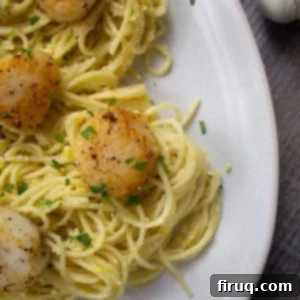
Lemon Pesto Spaghetti with Scallops
Vincent DelGiudice
Pin Recipe
30 minutes
15 minutes
45 minutes
Main Course
Italian
6 people
677 kcal
Equipment
-
1 food processor
-
1 large saucepan
-
1 large pot
Ingredients
- 1 lb spaghetti
- 3 lemons, carefully peeled (zest only)
- 2 cloves garlic, roasted
- 1 cup freshly grated Parmesan (or Parmigiana-Reggiano)
- 1 teaspoon kosher salt (or to taste)
- ½ cup cashews, toasted
- ½ cup extra virgin olive oil, high quality (plus more if needed)
- 1 lb large sea scallops, patted dry
- 1 tablespoon avocado oil (or other high-smoke-point oil)
- 2 tablespoons unsalted butter
- 1 clove garlic, smashed (for basting)
- Salt and freshly ground black pepper, to taste
Instructions
-
Prepare Lemon Rinds: Using a sharp knife or vegetable peeler, carefully zest the yellow part of 3 lemons, trying to avoid as much of the bitter white pith as possible. Place the lemon peels in a small pot with water, bring to a boil, and simmer for 5 minutes. This blanched step softens the peels and reduces bitterness. Drain and let cool slightly.
-
Toast Cashews: In a dry small pan over medium-high heat, toast the ½ cup cashews for about 5 minutes, tossing occasionally, until they are lightly browned and fragrant. This step is optional but highly recommended for enhanced flavor. Remove and let cool.
-
Roast Garlic: Preheat oven to 400°F (200°C). Place 2 garlic cloves (still in husks) on a small pan, drizzle with olive oil, and roast for 15 minutes until softened. Let cool, then squeeze garlic out of husks.
-
Cook Spaghetti: In a large pot, bring generously salted water to a rolling boil. Add 1 lb spaghetti and cook according to package directions until al dente. Before draining, reserve ½ cup of the starchy pasta water. Drain the spaghetti and set aside.
-
Make the Lemon Pesto: In a food processor, combine the cooled lemon peels, toasted cashews, roasted garlic, 1 cup grated Parmesan, and 1 teaspoon kosher salt. Process until finely ground. With the processor running, slowly drizzle in ½ cup extra virgin olive oil until the pesto is smooth and creamy. Adjust olive oil as needed to reach desired consistency.
-
Combine Pasta and Pesto: Return the hot, drained spaghetti to the large pot. Add the prepared lemon pesto and a few tablespoons of the reserved pasta water. Stir vigorously until the spaghetti is evenly coated with the vibrant, creamy pesto sauce. The pasta water helps create a silky, emulsified sauce.
-
Prepare Scallops: Gently remove the small side muscle from each 1 lb scallop. Pat them thoroughly dry with paper towels and season generously with salt and black pepper on all sides.
-
Sear Scallops: Heat 1 tablespoon avocado oil in a large, heavy-bottomed frying pan over medium-high heat until it shimmers. Add scallops one at a time, ensuring they are not overcrowded (cook in batches if necessary to achieve a good sear). Sear for about 90 seconds until a golden-brown crust forms. Carefully flip using a butter knife or small spatula and sear for another 1 minute on the other side.
-
Baste Scallops: Add 2 tablespoons unsalted butter and 1 smashed clove of garlic to the pan. Tilt the pan and baste the scallops with the melting butter and garlic for 1 minute. Remove scallops immediately from the pan to prevent overcooking.
-
Serve: Divide the lemon pesto spaghetti among plates and top each serving with the perfectly seared scallops. Garnish with fresh parsley or a lemon wedge if desired, and serve immediately.
Notes
- I always suggest using a butter knife to flip scallops because most people don’t have a small enough fish spatula to do this. The butter knife will delicately get under the scallop while you hold your finger on top. Flip the scallop over without ripping it off the pan.
- I listed a ½ cup of olive oil, but adjust as necessary when processing the pesto to arrive at a smooth and runny texture.
- For an even brighter flavor, a squeeze of fresh lemon juice can be added to the pesto just before tossing with pasta.
Nutrition
